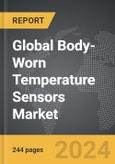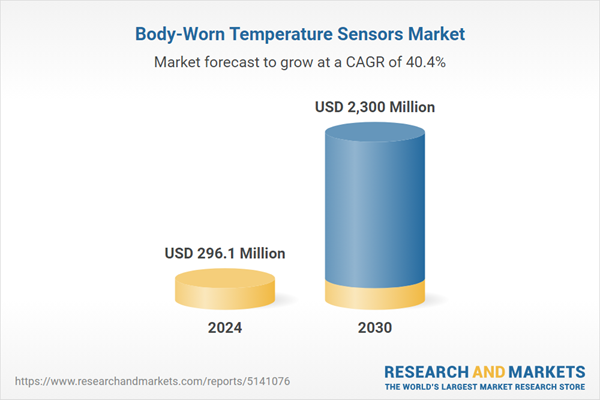The global market for Body-Worn Temperature Sensors was valued at US$296.1 Million in 2024 and is projected to reach US$2.3 Billion by 2030, growing at a CAGR of 40.4% from 2024 to 2030. This comprehensive report provides an in-depth analysis of market trends, drivers, and forecasts, helping you make informed business decisions. The report includes the most recent global tariff developments and how they impact the Body-Worn Temperature Sensors market.
Segments: Application (Fitness and Wellness, Infotainment, Healthcare and medical, Other Applications); Care Setting (Hospital, Home, Other Settings); Type (Wearable Motion Sensors, Wearable Pressure Sensors, Wearable Temperature Sensors, Wearable Position Sensors, Other Types).
Geographic Regions/Countries: World; United States; Canada; Japan; China; Europe (France; Germany; Italy; United Kingdom; and Rest of Europe); Asia-Pacific; Rest of World.
The analysts continuously track trade developments worldwide, drawing insights from leading global economists and over 200 industry and policy institutions, including think tanks, trade organizations, and national economic advisory bodies. This intelligence is integrated into forecasting models to provide timely, data-driven analysis of emerging risks and opportunities.
Global Body-Worn Temperature Sensors Market - Key Trends & Drivers Summarized
Why Are Body-Worn Temperature Sensors Gaining Popularity in Healthcare?
Body-worn temperature sensors are becoming increasingly popular in healthcare for continuous monitoring of body temperature, especially in managing chronic diseases and monitoring post-surgical recovery. These sensors, often integrated into wearable devices, provide real-time temperature readings, allowing healthcare providers to detect early signs of infection, fever, or other health anomalies. Their use has expanded significantly during the COVID-19 pandemic, where temperature monitoring became a critical tool for early detection of symptoms. Additionally, these sensors are being used in elderly care to monitor temperature fluctuations, particularly in patients with chronic conditions, providing a non-invasive method for continuous health monitoring.How Is Technology Advancing the Functionality of Body-Worn Temperature Sensors?
Technological advancements are enhancing the functionality and accuracy of body-worn temperature sensors. Miniaturization of sensors, along with the development of flexible, skin-friendly materials, has made these devices more comfortable for long-term wear. Wireless connectivity and real-time data transmission capabilities allow for continuous monitoring without the need for manual readings. Innovations in sensor accuracy have also reduced the margin of error in temperature measurements, making them more reliable for medical use. Furthermore, the integration of AI-powered analytics enables the detection of subtle temperature variations that could signal potential health issues, allowing for earlier and more accurate diagnoses.What Role Do Consumer Health Trends Play in the Adoption of Body-Worn Temperature Sensors?
Rising consumer interest in personal health monitoring is driving the adoption of body-worn temperature sensors. With an increasing focus on fitness, wellness, and preventive healthcare, consumers are seeking wearable devices that provide comprehensive health data, including body temperature. These sensors are often incorporated into multi-functional wearables such as fitness trackers and smartwatches, offering users a convenient way to monitor their health on the go. The growing awareness of the importance of early illness detection and the convenience of at-home health monitoring are further accelerating the demand for body-worn temperature sensors, especially among fitness enthusiasts, elderly individuals, and people with chronic conditions.The Growth in the Body-Worn Temperature Sensors Market Is Driven by Several Factors
The growth in the body-worn temperature sensors market is driven by several factors, including advancements in sensor technology, rising consumer demand for health monitoring devices, and the increasing need for remote healthcare solutions. The COVID-19 pandemic has significantly boosted the demand for temperature monitoring devices as a frontline diagnostic tool, a trend that continues post-pandemic as consumers and healthcare providers prioritize early illness detection. Technological innovations, such as miniaturization and improved sensor accuracy, are making these devices more user-friendly and reliable. Additionally, the growing trend toward wearable multi-sensor devices that track various health metrics, including temperature, is fueling the market's expansion.Report Scope
The report analyzes the Body-Worn Temperature Sensors market, presented in terms of units. The analysis covers the key segments and geographic regions outlined below.Segments: Application (Fitness and Wellness, Infotainment, Healthcare and medical, Other Applications); Care Setting (Hospital, Home, Other Settings); Type (Wearable Motion Sensors, Wearable Pressure Sensors, Wearable Temperature Sensors, Wearable Position Sensors, Other Types).
Geographic Regions/Countries: World; United States; Canada; Japan; China; Europe (France; Germany; Italy; United Kingdom; and Rest of Europe); Asia-Pacific; Rest of World.
Key Insights:
- Market Growth: Understand the significant growth trajectory of the Wearable Motion Sensors segment, which is expected to reach US$408.1 Million by 2030 with a CAGR of a 40.0%. The Wearable Pressure Sensors segment is also set to grow at 34.6% CAGR over the analysis period.
- Regional Analysis: Gain insights into the U.S. market, valued at $91.8 Million in 2024, and China, forecasted to grow at an impressive 37.6% CAGR to reach $302.6 Million by 2030. Discover growth trends in other key regions, including Japan, Canada, Germany, and the Asia-Pacific.
Why You Should Buy This Report:
- Detailed Market Analysis: Access a thorough analysis of the Global Body-Worn Temperature Sensors Market, covering all major geographic regions and market segments.
- Competitive Insights: Get an overview of the competitive landscape, including the market presence of major players across different geographies.
- Future Trends and Drivers: Understand the key trends and drivers shaping the future of the Global Body-Worn Temperature Sensors Market.
- Actionable Insights: Benefit from actionable insights that can help you identify new revenue opportunities and make strategic business decisions.
Key Questions Answered:
- How is the Global Body-Worn Temperature Sensors Market expected to evolve by 2030?
- What are the main drivers and restraints affecting the market?
- Which market segments will grow the most over the forecast period?
- How will market shares for different regions and segments change by 2030?
- Who are the leading players in the market, and what are their prospects?
Report Features:
- Comprehensive Market Data: Independent analysis of annual sales and market forecasts in US$ Million from 2024 to 2030.
- In-Depth Regional Analysis: Detailed insights into key markets, including the U.S., China, Japan, Canada, Europe, Asia-Pacific, Latin America, Middle East, and Africa.
- Company Profiles: Coverage of players such as BÃœRKERT FLUID CONTROL SYSTEMS, Glen Dimplex Professional Appliances - Lec Medical, Greentrol Automation, Inc., Makersan Makina Otomotiv San. Tic. A.S., PST Sensors (Pty) Ltd. and more.
- Complimentary Updates: Receive free report updates for one year to keep you informed of the latest market developments.
Some of the 42 companies featured in this Body-Worn Temperature Sensors market report include:
- BÃœRKERT FLUID CONTROL SYSTEMS
- Glen Dimplex Professional Appliances - Lec Medical
- Greentrol Automation, Inc.
- Makersan Makina Otomotiv San. Tic. A.S.
- PST Sensors (Pty) Ltd.
- TESLA BLATNA, a.s.
Tariff Impact Analysis: Key Insights for 2025
Global tariff negotiations across 180+ countries are reshaping supply chains, costs, and competitiveness. This report reflects the latest developments as of April 2025 and incorporates forward-looking insights into the market outlook.The analysts continuously track trade developments worldwide, drawing insights from leading global economists and over 200 industry and policy institutions, including think tanks, trade organizations, and national economic advisory bodies. This intelligence is integrated into forecasting models to provide timely, data-driven analysis of emerging risks and opportunities.
What’s Included in This Edition:
- Tariff-adjusted market forecasts by region and segment
- Analysis of cost and supply chain implications by sourcing and trade exposure
- Strategic insights into geographic shifts
Buyers receive a free July 2025 update with:
- Finalized tariff impacts and new trade agreement effects
- Updated projections reflecting global sourcing and cost shifts
- Expanded country-specific coverage across the industry
Table of Contents
I. METHODOLOGYII. EXECUTIVE SUMMARY2. FOCUS ON SELECT PLAYERSIII. MARKET ANALYSISIV. COMPETITION
1. MARKET OVERVIEW
3. MARKET TRENDS & DRIVERS
4. GLOBAL MARKET PERSPECTIVE
UNITED STATES
CANADA
JAPAN
CHINA
EUROPE
FRANCE
GERMANY
ITALY
UNITED KINGDOM
REST OF EUROPE
ASIA-PACIFIC
REST OF WORLD
Companies Mentioned (Partial List)
A selection of companies mentioned in this report includes, but is not limited to:
- BÃœRKERT FLUID CONTROL SYSTEMS
- Glen Dimplex Professional Appliances - Lec Medical
- Greentrol Automation, Inc.
- Makersan Makina Otomotiv San. Tic. A.S.
- PST Sensors (Pty) Ltd.
- TESLA BLATNA, a.s.
Table Information
| Report Attribute | Details |
|---|---|
| No. of Pages | 244 |
| Published | April 2025 |
| Forecast Period | 2024 - 2030 |
| Estimated Market Value ( USD | $ 296.1 Million |
| Forecasted Market Value ( USD | $ 2300 Million |
| Compound Annual Growth Rate | 40.4% |
| Regions Covered | Global |









